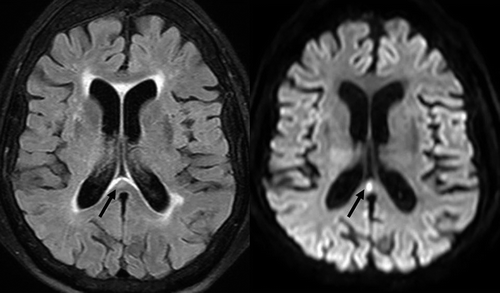To the Editor:
Sir,
Fever is a common postoperative condition and the diagnosis of drug-related hyperthermia may be then particularly challenging.Citation1
A 72-year-old woman suffering from obesity, hyperlipidemia, arterial hypertension and diabetes underwent a hip replacement for fracture. She was on chronic duloxetine therapy at a daily dose of 60 mg for chronic neuropathic pain. Other current medications included insulin, metformin, verapamil, montélukast, pantoprazole and enoxaparine. Postoperatively, she was administered acetaminophen (maximum 4 g/day) along with tilidine/naloxone (Valtran®) that was introduced after 48 h, but only four doses of 25 mg each were administered. On day 4 after surgery, the patient suddenly developed a hyperthermic syndrome with unconsciousness and respiratory failure leading to mechanical ventilation, but without muscle rigidity or clonus. She was admitted to the intensive care unit (ICU) with a Glasgow Coma Score of 3/15; heart rate, 128/min; and arterial blood pressure, 111/67 mmHg. Her rectal temperature rapidly increased up to 42.2°C but the life-threatening hyperthermia was successfully treated using an ice pack, a fan and a cooling blanket. After the withdrawal of the neuromuscular blockers that were administered for 22 h in order to prevent shivering, spontaneous myoclonus was noted on the face and the upper limbs. The electroencephalogram showed only diffuse slowing (3–4 Hz). Laboratory investigations revealed a moderate rhabdomyolysis (CK 1318 IU/l, [normal < 200]), with mixed acidosis (arterial pH 7.09, pCO2 70 mmHg, bicarbonate 19 mmol/l, base excess − 10.3 mmol/l, anion gap 18 mmol/l, lactate 2.9 mmol/l) and renal function impairment (serum creatinine 2.52 mg/dl). A brain magnetic resonance imaging (MRI) performed a few hours after ICU admission demonstrated the presence of a mid-sagittal focus of abnormal hyperintensity within the corpus callosum on both the T2/FLAIR and the diffusion-weighted images (). Apparent Diffusion Coefficient (ADC) mapped images showed decreased water diffusivity within the lesion, thereby demonstrating cytotoxic oedema. The patient fully emerged from coma 5 days after admission and completely recovered from metabolic disorders.
Fig. 1. Brain MRI examination at admission: unspecific subependymal hyperintensities corresponding to chronic leukoaraiosis are seen on left-sided FLAIR image together with a less common focus of hypersignal intensity within the splenium of the corpus callosum (arrow). Right-sided corresponding DW image in similar slice location shows disappearance of all chronic lesions but highlights the callosal lesion as an acute area of decreased water diffusivity (arrow).

Drug-induced life-threatening hyperthermia is mostly linked to anaesthetics-related malignant hyperthermia, antidopaminergic syndrome or serotonin syndrome (SS). In its classical form, SS may be suspected from the presence of clonus, agitation, sweating, tremor and hyperreflexia. Atypical presentation with severe hyperthermia and altered consciousness can be observed. Duloxetine in overdose, or even after a single ingestion, has been associated with SS.Citation2 In the present observation, the recent introduction of tilidine/naloxone was suspected as a precipitating factor. Synthetic opioids including fentanyl, methadone, meperidine, propoxyphene, dextromethorphan and tramadol have been evidenced to have a proserotoninergic action, but not tilidine which is less commonly prescribed.Citation3,Citation4 Tilidine is a prodrug that is metabolized to the active nortilidine and to bisnortilidine, under the influence of cytochrome P4503A4. There is no significant drug–drug interaction reported between duloxetine and tilidine. However, as our patient was also taking verapamil, a potent CYP3A4 inhibitor, the metabolic clearance of tilidine could have been modified, with an increased exposure to the active nortilidine.Citation5 Our patient could also have some predisposing factors (hypertension and hyperlipidemia) leading to a reduced endothelial monoamine oxidase activity.Citation4,Citation6
To sum up, severe hyperthermia may be associated with unusual brain MRI findings. Solitary and reversible areas of restricted water diffusivity of speculative physiopathology within the splenium of corpus callosum have been rarely described in febrile encephalopathy after infections, seizure, or in patients presenting with a neuroleptic malignant syndrome.Citation7 Such lesions appear hyperintense on both T2/FLAIR and DW images at the acute phase, and thereafter disappear within a short delay.
Declaration of interest
The authors report no conflicts of interest. The authors alone are responsible for the content and writing of the paper.
References
- Shaikh ZS, Krueper S, Malins TJ. Serotonin syndrome: take a closer look at the unwell surgical patient. Ann R Coll Surg Engl 2011; 93: 569–572.
- Gelener P, Gorgulu U, Kutlu G, Ucler S, Inan LE. Serotonin syndrome due to duloxetine. Clin Neuropharmacol 2011; 34:127–128.
- Rastogi R, Swarm RA, Patel TA. Case scenario: opioid association with serotonin syndrome: implications. Anesthesiology 2011; 115:1291–1298.
- Guo SL, Wu TJ, Liu CC, Ng CC, Chien CC, Sun HL. Meperidine-induced serotonin syndrome in a susceptible patient. Br J Anaesth 2009; 103:369–370.
- Grün B, Merkel U, Riedel K-D, Weiss J, Mikus G. Contribution of CYP2C19 and CYP3A4 to the formation of the active nortilidine from the prodrug tilidine. Br J Clin Pharmacol 2012; 74:854–863.
- Brown TM, Skop BP, Mareth TR. Pathophysiology and management of the serotonin syndrome. Ann Pharmacother 1996; 30:527–533.
- Al-Edrus SA, Norzaini R, Chua R, Puvanarajah S, Shuguna M, Muda S. Reversible splenial lesion syndrome in neuroleptic malignant syndrome. Biomed Imaging Interv J 2009; 5:e24.